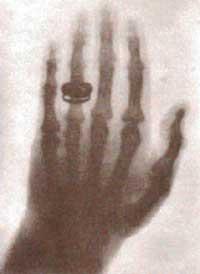First unexpected x-ray

It has always been said that discoveries are achieved thanks to work, knowledge and time, but in some cases luck also helps a lot. It could be thought that in 1895, in the case of scientist Wilhelm Conrad Röntgen, all these factors influenced. The laboratory was studying what happened when the electric current passed through a low pressure gas, and thanks to this work discovered new and different types of rays.
It was the evening of November 8, 1895. He surrounded the discharge tube with a thick cardboard and worked in a dark room isolated from light. In front of this discharge tube was placed a thin sheet of barium cyanide that observed that during the operation of the discharge tube emitted fluorescent rays. In the experiments he then interspersed objects of different thickness in the path of the rays and verified that when reflecting them on the photographic plate they had different degree of transparency. For a moment, he placed his wife's hand in the path of the rays and the shadow of the bones of his hand appeared clearly on the photographic plate. Hand meat could also stand out, though more diffuse than bones.

This was the first röntgenogram obtained. In experiments since then, Röntgen showed that these new rays occur when cathodic rays collide with the material object. Mathematicians call X the unknown number and following that custom Röntgen baptized the ray with the name X-ray. Later, Max von Laue and his team of researchers discovered that the rays had the same electromagnetic origin as light.
X-rays
But what are x-rays? X-rays are a type of electromagnetic wave. And they have a wavelength ten thousand times shorter than visible light (10 -12 cm wavelength). Therefore, they are much more energetic than visible light. They are very penetrating and can cause serious damage to the body (tissue destruction, skin burns, DNA damage, etc. ). The biological effects of radiation are measured by equivalent dose and their unit is sievert (Sv). If the doses received are high, the damage is immediate. In low doses, however, the damages appear longer term.

Depending on the thickness, density or composition of body tissues, X-rays are absorbed differently as the body is traversed. For example, when x-rays pass through our body, they are counteracted more strongly in the bones, so the shadow of the bones is cleaner in the x-ray image. Therefore, in X-rays the shadows provide us with information about the internal structure.
The human being cannot see them at first glance, but being able to darken photographic emulsions, they soon applied to medicine to, among other things, perform X-rays. In fact, X-rays are images obtained as a result of X-ray action.
X-ray applications
X-rays are those done in the hospital or outpatient. However, do not forget that in addition to exploring our bones, they are very useful for many other tasks.
In addition to medicine, X-rays are widely used in the industry. X-ray diffraction is performed to correct changes in chemical compositions and failures within materials. X-ray diffraction spectroscopy can only study the crystalline structure. However, this analytical technique has become very important, among other things, in protein research. Proteins are isolated and crystallized first. The X-rays are then sent, and if you measure the amount and position of the rays that are diffracted, you can know the three-dimensional structure of the molecule.


Another important use is made in artistic works, especially in paintings. In fact, X-rays allow us to know the state of the paintings and their origin. The X-ray also ‘denounces’ the techniques the painter has used or the last tweaks he has given to the work.
X-rays also have their application in astronomy. In fact, some telescopes, such as the NASA Chandra Telescope, receive X-rays instead of visible light, and then normally pair the optical image with the image received through X-rays. In the latter the details are always observed with greater precision.
The acquired fame of this important discovery allowed Röntgen to devote much of his life to nature, a passionate mountaineer and nature lover. He died on 10 February 1923 in intestinal carcinoma.





